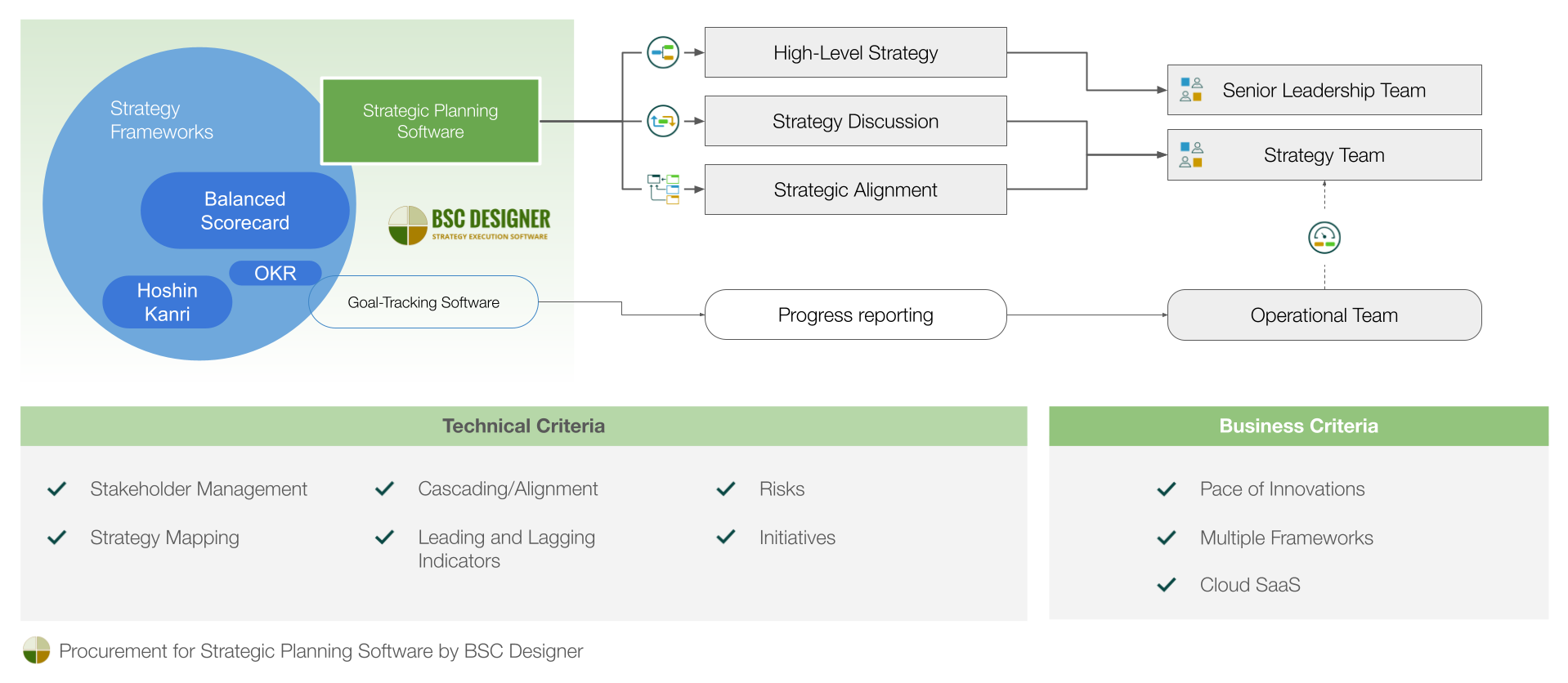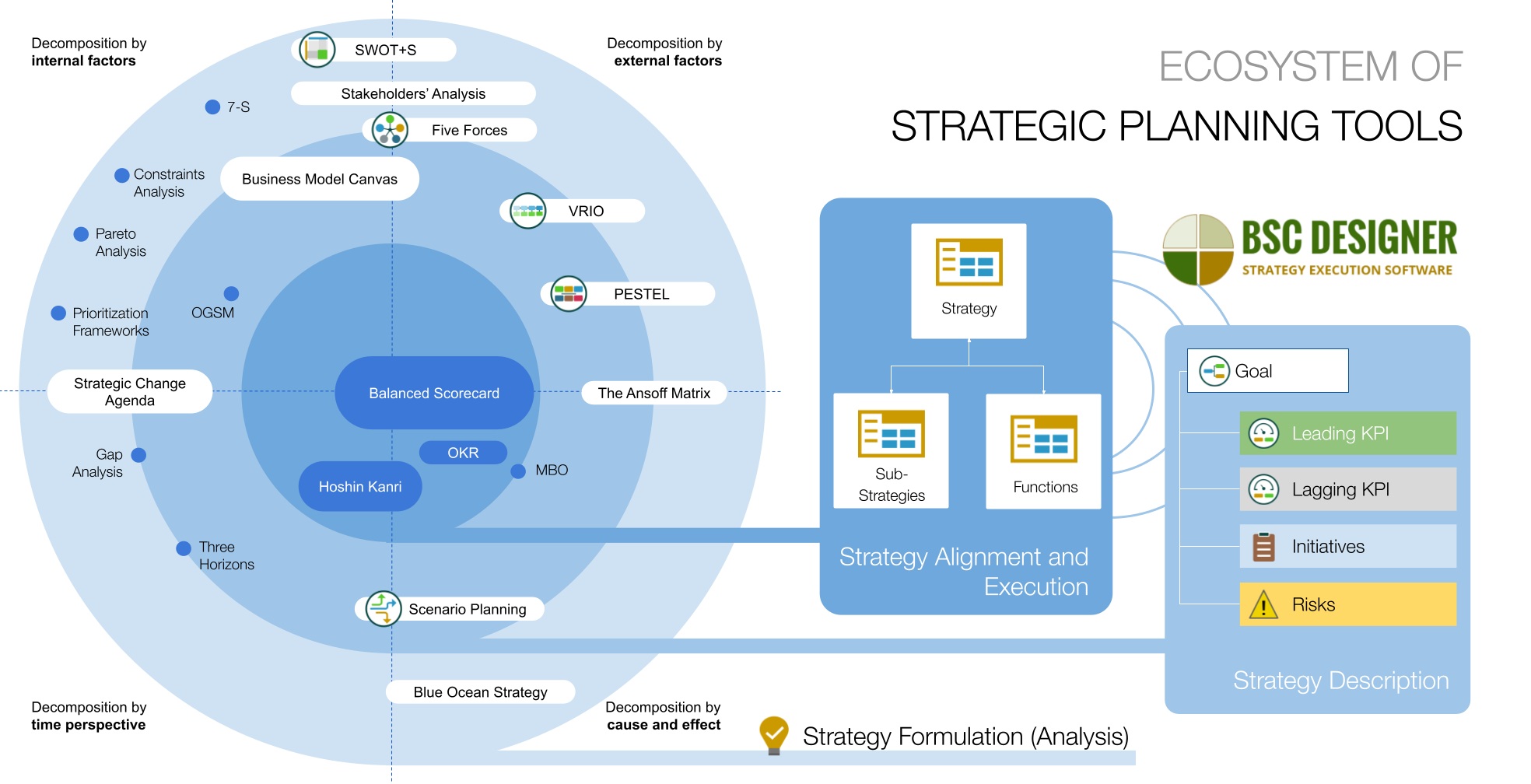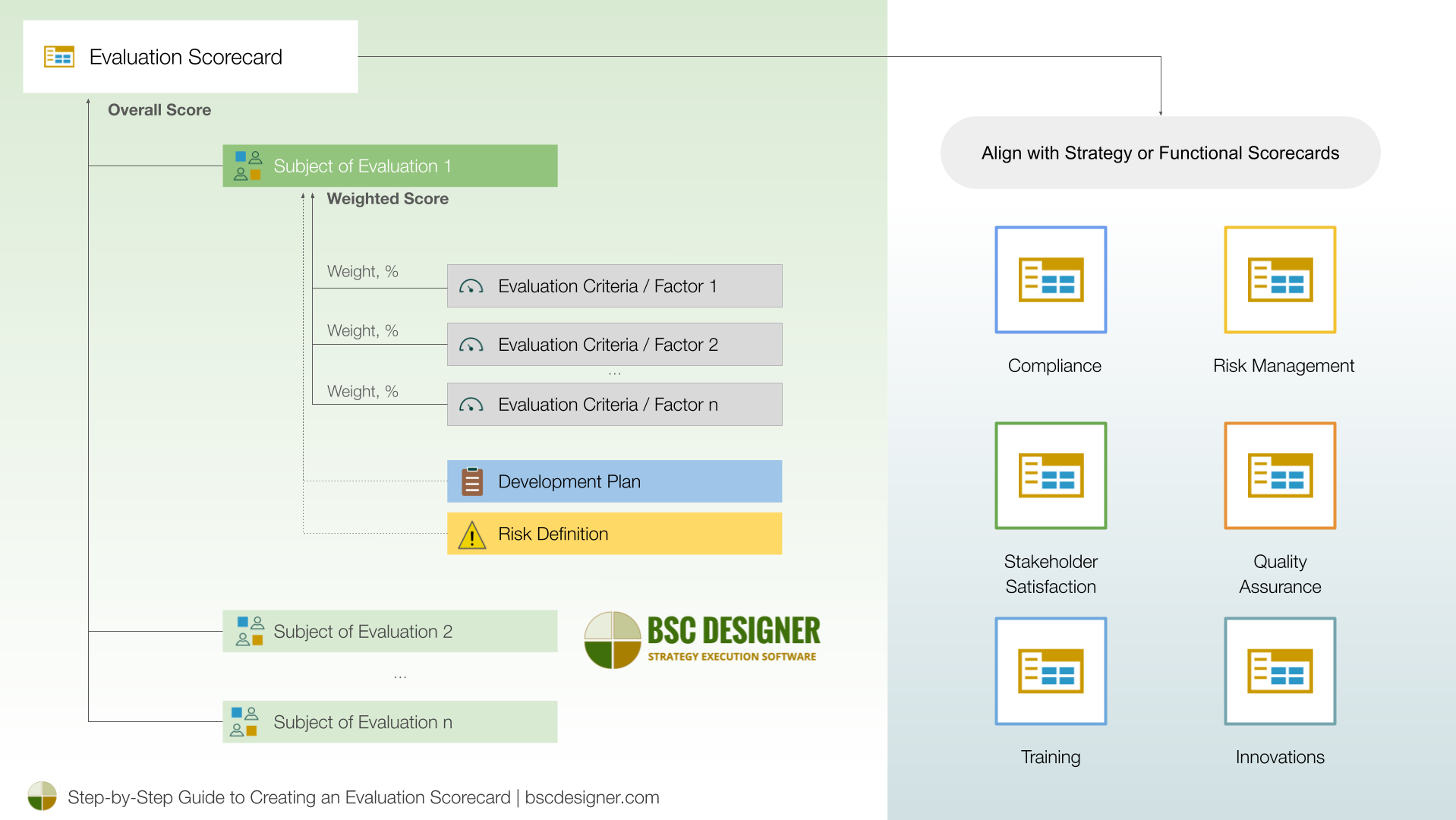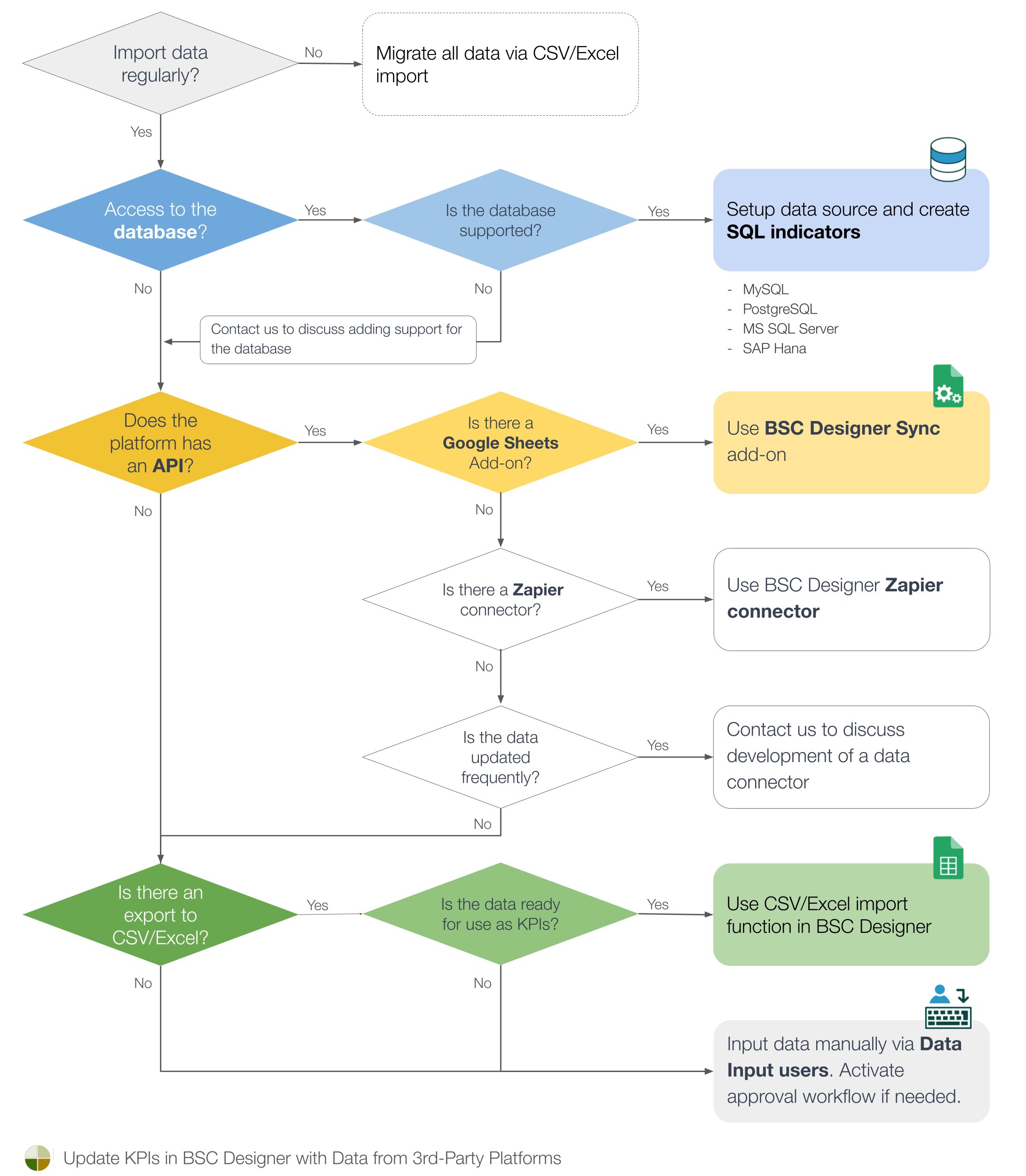As a vendor of BSC Designer, strategic planning software, we regularly receive Requests for Proposals (RFP) from procurement departments. In this article, I’d like to share some advice that would help companies with the choice of strategy planning software.

I’ve structured the article to cover these topics:
- Class of the software: Balanced Scorecard vs. Strategic Planning vs. Goal-Tracking
- Key features of specialized strategic planning tools
- Generic business criteria to consider (pace of innovation, support)
- Technical nuances to be prepared for
If you think there are some additional criteria, please share in the comments.
Introduction: What is Specialized Strategic Planning Software?
Let’s start with a definition of what we are looking for and what we are not.
Balanced Scorecard vs. Strategic Planning Software
Let’s begin by highlighting the difference between ‘Balanced Scorecard’ and ‘Strategic Planning’ software.
A low-hanging answer is simple:
The Balanced Scorecard software automates the K&N Balanced Scorecard framework, while strategic planning software is a more general term that refers to the automation of a wider range of business models.
To provide a more specific answer, let’s examine the ecosystem of strategic planning frameworks.
Each framework suggests its own unique approach to decomposing the complexities of the external and internal environment. While we place the Balanced Scorecard in the segment of strategy execution frameworks, there are other supporting frameworks, such as PESTEL, Five Forces, and Stakeholder Analysis, addressing the challenges of strategic planning from different angles.
When using the K&N Balanced Scorecard in practice, you need to:
- Connect it to the analysis of external factors (PESTEL framework),
- Map the expectations of internal and external customers (derived from Stakeholder analysis),
- Take into account competition, and connect to some supporting (functional) scorecards, etc.
In this sense, the term “strategic planning software” is a more versatile explanation of what an organization is looking for.
OKRs vs. Strategic Planning Software
Similar to the Balanced Scorecard, OKRs framework occupies the strategy execution segment on our diagram. In terms of automation, the same ideas apply: in a real business environment, the framework will need inputs from other business tools.
At first glance, OKRs might seem completely different, but if we look beyond the difference in terminology, it appears that the OKRs framework can be automated according to a typical goals/KPIs/initiatives model.
Another aspect to mention: within the architecture of aligned strategy scorecards, organizations can follow various execution frameworks depending on the level of decomposition. Some of our clients have successfully mixed the classical Balanced Scorecard with the lightweight OKRs.
What Framework does BSC Designer Support?
BSC Designer was initially focused on the Balanced Scorecard framework only. Following the changing needs of our customers, we shifted towards a more comprehensive solution. Our current vision of strategic planning is explained in the Strategy Implementation System.
A short summary from the Implementation System is that for effective strategy execution, we need to start with an analysis of stakeholder needs, combine various business frameworks, break down complex goals into three quanta (goals, KPIs, initiatives), organize these quanta into scorecards, and finally, align the scorecards together to form a comprehensive strategy.
Goal Tracking vs. Strategic Planning Software
Another source of confusion arises from the marketing specialists of goal-tracking software.
In an attempt to address all markets, they tend to present their tools as a universal solution for any challenge, including strategic planning. This is why you may come across comparison lists of ‘strategic planning’ tools that don’t list any known strategic planning brand, only common productivity/communication tools. Don’t be surprised; simply explore further.
The goal tracking software is effective for its application area, but it may not align with the needs of the strategy team.
Consider the choice of power tools:
A drill for small home repairs won’t replace the one that building contractors use.
In this sense, goal tracking tools are something every member of your team should have to report on their progress, while specialized strategy execution software will be mostly used by the strategy team to see the high-level picture and track strategic initiatives.
The difference between ‘operational’ and ‘strategic’ in this case is not merely semantic; it also reflects a specific choice of tools optimized to work with a higher level of uncertainty within the business landscape of the GRC (Governance, Risk, Compliance) domain.
Users and Roles in Adopting Strategic Planning Software
One of the factors that define the budget designated for purchasing a subscription for strategic planning software, as well as its future effectiveness, is how many employees are involved in strategic planning.
You might have heard the saying that strategy should be everyone’s job in the organization. This statement makes some sense if we are talking about strategy execution, but when it comes to strategy development, the roles of employees vary depending on the organization and the maturity of its strategic planning process.
We define three tiers of employees depending on their involvement in strategic planning:
- Tier 1. Awareness
- Tier 2. Contribution
- Tier 3. Collaboration/Ownership
When scaling up to the business unit, department, or organizational level, we are talking about various levels of strategic planning maturity:
- Level 1. Formal strategy
- Level 2. Cascaded strategy
- Level 3. Collaborative strategy
Additionally, with the growing complexity of the organization, the role of the Office of Strategy Management emerges.
Must-Have Features of Strategic Planning Software
A software tool specialized in strategic planning should natively support these functions:
- Stakeholder management and alignment. Identification of stakeholders and implementing their strategic ambitions.
- Strategy mapping. The one-page strategy map derived from the K&N Balanced Scorecard is a powerful tool to communicate strategy.
- Leading and Lagging Indicators. While any goal tracking tool quantifies progress, in strategic planning, we need to distinguish progress related to success factors (leading indicators) and outcomes (quantified by lagging indicators).
- Initiatives. In strategic planning, goals or objectives play the main role; the KPIs and initiatives are secondary roles. That’s a good differentiator for goal-setting tools that are task-centric.
- Alignment or Cascading. In the best case, goal-tracking tools see the strategy as a pyramid where low-level elements contribute to higher levels; this works on an operational level. On a strategic level, the mechanics change – sometimes it is the mentioned hierarchical connection, sometimes it is contextual connections. The degree of volatility and ambiguity in strategic planning is much higher, so we might need to connect various sub-strategies.
- Risk Management. The effect of uncertainty is important in the domain of strategic planning; we consider risk when formulating goals and working on initiatives.
Business Criteria for Choice
Let’s discuss some common business criteria for the choice of specialized strategic planning software.
Pace of Innovations
In my Medium article on innovations, I recommended that companies become ‘systematic innovators,’ using Singapore Airlines and Tesla as examples.
When shortlisting a strategic planning solution, choose vendors that regularly improve their product. Look for release logs, announcements of new versions on YouTube, and discussions in user groups.
Support and Training
Tesla not only led the transition to electric vehicles but also changed the sales and post-service model, cutting unnecessary fees of local car dealers. Ideally, the software you are going to use should require no specific training to get started and should include relevant interactive training materials.
There should be someone on the support team who can help you, but having someone visit you on-site might be an unnecessary cost.
Finally, if the software you are going to use is in the cloud, why should the support be provided on-site?
Established Business
Continuing the theme of innovation and personalized support, I would focus procurement on a pool of vendors with at least 5 years of experience in the domain of strategic planning.
The extensive theoretical foundation of strategic planning limits new entrants from rapidly developing professional software.
Multiple Frameworks Supported
Avoid tools that specialize in a single strategic planning framework, such as OKR, Hoshin Kanri, or Balanced Scorecard exclusively.
The complexity of the business environment will require your organization to approach challenges from different perspectives, involving various frameworks and supporting tools.
The flexibility of the automation software and its ability to adapt to various business tools is key to optimizing the total cost of ownership.
Testimonials, Reviews, Opinions
Review websites like G2 can be helpful, but in the case of strategic planning software, don’t be impressed by the large number of reviews. Among our competitors, there are established strategic planning software businesses that don’t have 1000+ reviews simply because they prioritize development over marketing.
In the case of BSC Designer, our prospective customers were never interested in generic reviews; instead, they asked about the application of the software to a specific business domain or the existence of references from their region. You can find and filter the required information in the customer stories section.
Technical Criteria for the Choice of Strategic Planning Software
Let’s discuss some technical criteria to consider when choosing strategic planning software. If you plan to use a comprehensive set of criteria to evaluate potential vendors, consider using the evaluation scorecard template available in BSC Designer to score vendors.
Cloud is Preferred Choice over On-site
Starting approximately in 2014, we saw a decline in interest in the implementation of the hosted version. After Covid-19, most companies prefer the cloud as the guaranteed way to always have access to the latest version and remove onsite maintenance.
Unless you are in a strictly regulated industry, focus on cloud-based strategic planning solutions.
Search for tools with:
- Proper data governance mechanics implemented and
- The possibility to migrate data to avoid lock-in.
Any Europe-based company should provide this functionality in accordance with data privacy regulation.
Responsive Web is Preferred Over Native Apps
This recommendation may seem paradoxical, but practice shows that responsive web tools outperform native apps in the long run. The reason is that maintaining the same pace of development for various platforms (desktop, web, iOS, Android) is challenging. If a software vendor aims to provide the best-in-class experience, there should be a focus on one thing. Otherwise, we will see outdated apps that lack important functions compared to their web versions.
Mobile-first companies (such as fintech startups, for example) concentrate their main development efforts on native apps. In the case of strategic planning software, smartphones are primarily used for viewing strategies and quick data inputs, while the primary work occurs on desktops or tablets.
Learn more about how the BSC Designer app adapts to smartphone screens.
Prepare for AI with Detailed Audit Trail
The state of development of AI is still far from replacing strategists, but it is reasonable to forecast that in the next decade its co-piloting role will disrupt the way strategies are created.
When choosing a strategic planning tool, consider the software’s capability to retain activity logs or an audit trail. Today, this may seem like a minor feature relevant only for compliance purposes, but think about the vast amount of relevant data it could provide to future AI.
Imagine an AI tool that understands and remembers the rationale behind all the decisions you made, all strategic hypotheses that you validated, their results, cross-dependencies, and ever-changing external factors. Imagine an AI that will utilize all this information to support your team with decisions you make today.
The current state of AI is not there yet, but it’s critical to start collecting all the relevant data today. In practice, this means digitizing your strategy in the first place and using digital tools for all future strategy discussion sessions.
Migrating Existing Strategy
A typical implementation of strategic planning software starts with the migration of the existing strategy. Most likely, you will find some automation tools for migration, like we have in our software.
In the procurement stage, it’s a good idea to provide the vendor with a sample of your strategy data in Excel to estimate the possibility to import and the need for some data pre-processing.
Connecting to Datasource
A typical challenge when implementing a strategic planning tool is to connect it to existing business solutions. It’s possible to create a seamless connection if the business tools you use have interfaces for third-party tools.
The requirement for ‘full integration of XYZ solution’ won’t make sense for the vendor of strategic planning software. When working on requests for proposals, try to answer these questions:
- What tools need to be integrated with the strategy planning tool?
- Do those tools have cloud access via API?
- What kind of data needs to be shared?
- Is it structured/aggregated data?
Here is the diagram we recommend for users of our software to address data integration challenges.
In the case of BSC Designer, we have various connectors that users can apply.
Test Waters by Creating a Prototype
If you filter out obvious outsiders (the goal-setting tools), the feature set presented by the specialized strategic planning tool will be similar.
The major difference is how the software feels and if it fits the strategy culture that you follow in your organization.
There is no fast track here; the only way is to shortlist 3-5 tools, sign up with a test version, and try building a prototype.
Legacy Data
The implementation of strategic planning software is also a way to refresh your performance management culture. Don’t try to migrate all your legacy data to the tool. Automation helps to avoid a lot of unnecessary paperwork. See the approach promoted by the tool, decide what to take with you into the new software.
Conclusions
Strategic planning tools play a crucial role in guiding organizations through the VUCA period (volatility, uncertainty, complexity, and ambiguity). These tools are designed to manage educated hypotheses, prioritizing adaptability over rigid plans.
Throughout the article, we explored the essential stages of the procurement process, offering recommendations to facilitate the decision-making journey.
For further discussion regarding your requirements for automating your strategy, please review the official ![]()
BSC Designer is strategy execution software that enhances strategy formulation and execution through tangible KPIs. Our proprietary strategy implementation system reflects our practical experience in the strategy domain.




